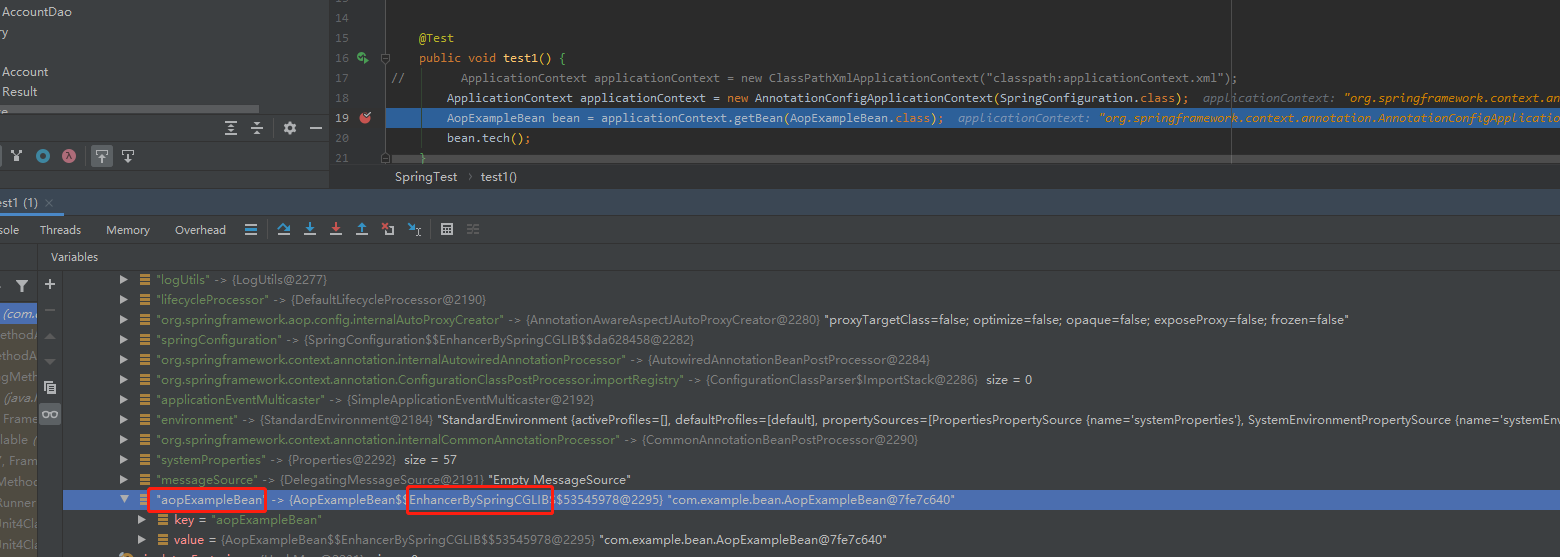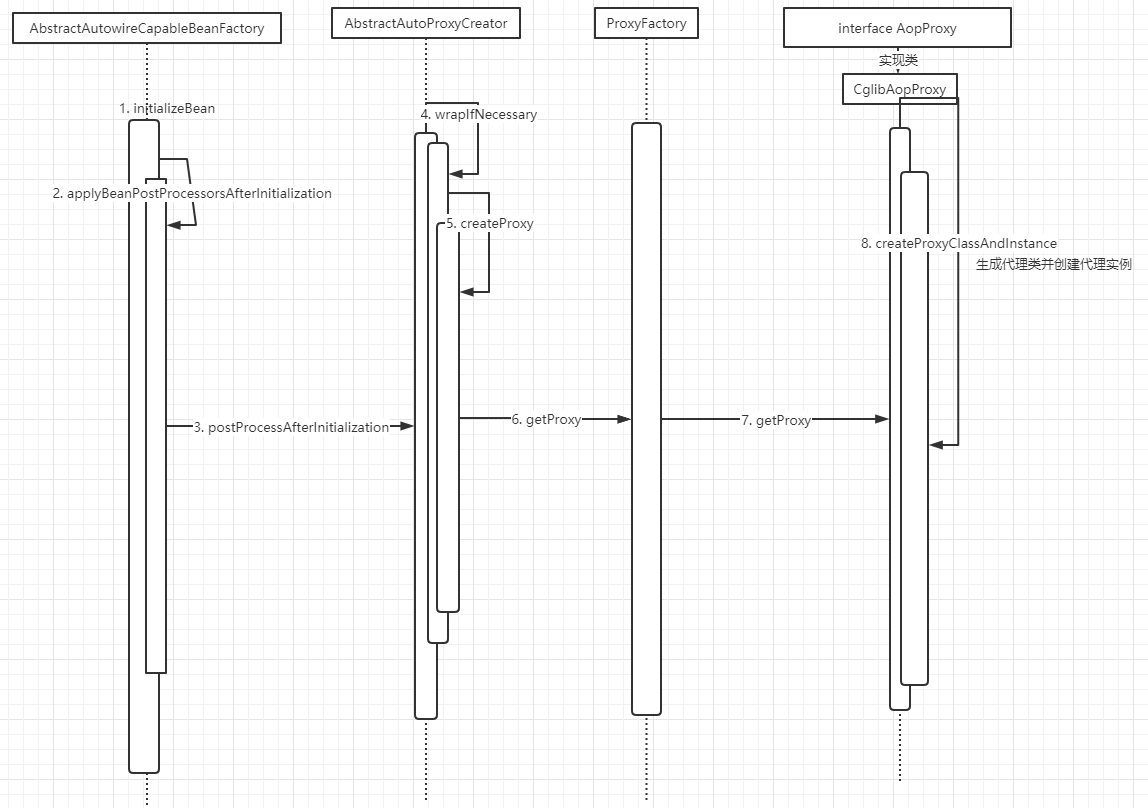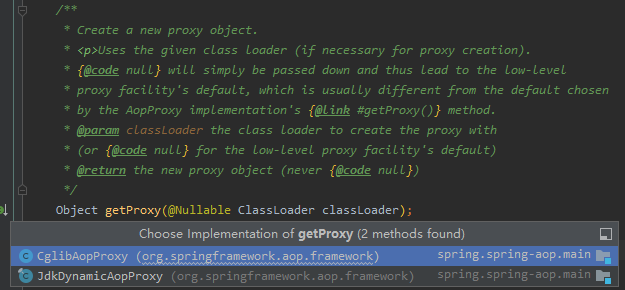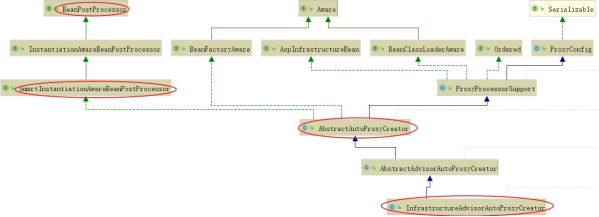Spring AOP源码深度剖析
1. 代理对象创建
1.1 aop基础用例准备
Bean定义
@Component
public class AopExampleBean {
public void tech() {
System.out.println("com.example.test.bean.AopExampleBean.tech....");
}
}
Aspect定义
@Component
@Aspect
public class ExampleAspect {
@Pointcut("execution(* com.example.*.*(..))")
public void pointcut(){
}
@Before("pointcut()")
public void before() {
System.out.println("before method ......");
}
}
测试代码
@Test
public void test1() {
// ApplicationContext applicationContext = new ClassPathXmlApplicationContext("classpath:applicationContext.xml");
ApplicationContext applicationContext = new AnnotationConfigApplicationContext(SpringConfiguration.class);
AopExampleBean bean = applicationContext.getBean(AopExampleBean.class);
bean.tech();
}
1.2 debug分析栈中singletonObjects中返回的ExampleBean
 我们发现在 getBean 之前,Bean对象已经产⽣(即在第⼀⾏初始化代码中完成),⽽且该对象是⼀个代理对象(Cglib代理对象),我们断定,容器初始化过程中⽬标Ban已经完成了代理,返回了代理对象。
我们发现在 getBean 之前,Bean对象已经产⽣(即在第⼀⾏初始化代码中完成),⽽且该对象是⼀个代理对象(Cglib代理对象),我们断定,容器初始化过程中⽬标Ban已经完成了代理,返回了代理对象。
1.3 代理对象创建流程

1.3.1 AbstractAutowireCapableBeanFactory#initializeBean() 初始化Bean开始
/**
* Initialize the given bean instance, applying factory callbacks
* as well as init methods and bean post processors.
* <p>Called from {@link #createBean} for traditionally defined beans,
* and from {@link #initializeBean} for existing bean instances.
* @param beanName the bean name in the factory (for debugging purposes)
* @param bean the new bean instance we may need to initialize
* @param mbd the bean definition that the bean was created with
* (can also be {@code null}, if given an existing bean instance)
* @return the initialized bean instance (potentially wrapped)
* @see BeanNameAware
* @see BeanClassLoaderAware
* @see BeanFactoryAware
* @see #applyBeanPostProcessorsBeforeInitialization
* @see #invokeInitMethods
* @see #applyBeanPostProcessorsAfterInitialization
*
* 初始化Bean
* 包括Bean后置处理器初始化
* Bean的⼀些初始化⽅法的执⾏init-method
* Bean的实现的声明周期相关接⼝的属性注⼊
*
*/
protected Object initializeBean(final String beanName, final Object bean, @Nullable RootBeanDefinition mbd) {
// 执⾏所有的AwareMethods
if (System.getSecurityManager() != null) {
AccessController.doPrivileged((PrivilegedAction<Object>) () -> {
invokeAwareMethods(beanName, bean);
return null;
}, getAccessControlContext());
}
else {
invokeAwareMethods(beanName, bean);
}
Object wrappedBean = bean;
if (mbd == null || !mbd.isSynthetic()) {
// 执⾏所有的BeanPostProcessor#postProcessBeforeInitialization 初始化之前的处理器⽅法
wrappedBean = applyBeanPostProcessorsBeforeInitialization(wrappedBean, beanName);
}
// 开始执⾏afterPropertiesSet(实现了InitializingBean接⼝)⽅法和initMethod
try {
invokeInitMethods(beanName, wrappedBean, mbd);
}
catch (Throwable ex) {
throw new BeanCreationException(
(mbd != null ? mbd.getResourceDescription() : null),
beanName, "Invocation of init method failed", ex);
}
if (mbd == null || !mbd.isSynthetic()) {
// 执行后置处理器,进行增强
wrappedBean = applyBeanPostProcessorsAfterInitialization(wrappedBean, beanName);
}
return wrappedBean;
}
1.3.2 applyBeanPostProcessorsAfterInitialization()
@Override
public Object applyBeanPostProcessorsAfterInitialization(Object existingBean, String beanName)
throws BeansException {
Object result = existingBean;
// 循环执行所有的后置处理器
for (BeanPostProcessor processor : getBeanPostProcessors()) {
Object current = processor.postProcessAfterInitialization(result, beanName);
if (current == null) {
return result;
}
result = current;
}
return result;
}
1.3.3 AbstractAutoProxyCreator#postProcessAfterInitialization() 使用配置的拦截器创建代理
/**
* Create a proxy with the configured interceptors if the bean is
* identified as one to proxy by the subclass.
* @see #getAdvicesAndAdvisorsForBean
*
* 如果bean被子类标识为要代理的代理,则使用配置的拦截器创建代理。
*/
@Override
public Object postProcessAfterInitialization(@Nullable Object bean, String beanName) {
if (bean != null) {
// 检查下该类是否已经暴露过了(可能已经创建了,⽐如A依赖B时,创建A时候,就会先去创建B。
// 当真正需要创建B时,就没必要再代理⼀次已经代理过的对象),避免重复创建
Object cacheKey = getCacheKey(bean.getClass(), beanName);
if (this.earlyProxyReferences.remove(cacheKey) != bean) {
// 包装类
return wrapIfNecessary(bean, beanName, cacheKey);
}
}
return bean;
}
1.3.4 wrapIfNecessary()
/**
* Wrap the given bean if necessary, i.e. if it is eligible for being proxied.
* @param bean the raw bean instance
* @param beanName the name of the bean
* @param cacheKey the cache key for metadata access
* @return a proxy wrapping the bean, or the raw bean instance as-is
*
* 必要时包装给定的bean,即是否有资格被代理。
*/
protected Object wrapIfNecessary(Object bean, String beanName, Object cacheKey) {
if (StringUtils.hasLength(beanName) && this.targetSourcedBeans.contains(beanName)) {
return bean;
}
if (Boolean.FALSE.equals(this.advisedBeans.get(cacheKey))) {
return bean;
}
if (isInfrastructureClass(bean.getClass()) || shouldSkip(bean.getClass(), beanName)) {
this.advisedBeans.put(cacheKey, Boolean.FALSE);
return bean;
}
// Create proxy if we have advice.
Object[] specificInterceptors = getAdvicesAndAdvisorsForBean(bean.getClass(), beanName, null);
if (specificInterceptors != DO_NOT_PROXY) {
this.advisedBeans.put(cacheKey, Boolean.TRUE);
// 创建代理bean
Object proxy = createProxy(
bean.getClass(), beanName, specificInterceptors, new SingletonTargetSource(bean));
this.proxyTypes.put(cacheKey, proxy.getClass());
return proxy;
}
this.advisedBeans.put(cacheKey, Boolean.FALSE);
return bean;
}
1.3.5 创建代理Bean createProxy(bean.getClass(), beanName, specificInterceptors, new SingletonTargetSource(bean));
/**
* Create an AOP proxy for the given bean.
* @param beanClass the class of the bean
* @param beanName the name of the bean
* @param specificInterceptors the set of interceptors that is
* specific to this bean (may be empty, but not null)
* @param targetSource the TargetSource for the proxy,
* already pre-configured to access the bean
* @return the AOP proxy for the bean
* @see #buildAdvisors
*
* 创建aop代理类
*/
protected Object createProxy(Class<?> beanClass, @Nullable String beanName,
@Nullable Object[] specificInterceptors, TargetSource targetSource) {
if (this.beanFactory instanceof ConfigurableListableBeanFactory) {
AutoProxyUtils.exposeTargetClass((ConfigurableListableBeanFactory) this.beanFactory, beanName, beanClass);
}
// 创建代理工厂
ProxyFactory proxyFactory = new ProxyFactory();
proxyFactory.copyFrom(this);
// 况判断是否要设置proxyTargetClass=true
if (!proxyFactory.isProxyTargetClass()) {
if (shouldProxyTargetClass(beanClass, beanName)) {
proxyFactory.setProxyTargetClass(true);
}
else {
evaluateProxyInterfaces(beanClass, proxyFactory);
}
}
//把指定和通⽤拦截对象合并, 并都适配成Advisor
Advisor[] advisors = buildAdvisors(beanName, specificInterceptors);
proxyFactory.addAdvisors(advisors);
proxyFactory.setTargetSource(targetSource);
customizeProxyFactory(proxyFactory);
proxyFactory.setFrozen(this.freezeProxy);
if (advisorsPreFiltered()) {
proxyFactory.setPreFiltered(true);
}
// 开始创建代理
return proxyFactory.getProxy(getProxyClassLoader());
}
1.3.6 开始创建代理 proxyFactory.getProxy(getProxyClassLoader())
/**
* Create a new proxy according to the settings in this factory.
* <p>Can be called repeatedly. Effect will vary if we've added
* or removed interfaces. Can add and remove interceptors.
* <p>Uses the given class loader (if necessary for proxy creation).
* @param classLoader the class loader to create the proxy with
* (or {@code null} for the low-level proxy facility's default)
* @return the proxy object
*/
public Object getProxy(@Nullable ClassLoader classLoader) {
// ⽤ProxyFactory创建AopProxy, 然后⽤AopProxy创建Proxy, 所以这⾥重要的是看获取的AopProxy对象是什么,
// 然后进去看怎么创建动态代理, 提供了两种:jdk proxy, cglib
return createAopProxy().getProxy(classLoader);
}
1.3.7 创建代理对象 AopProxy: createAopProxy()
/**
* Subclasses should call this to get a new AOP proxy. They should <b>not</b>
* create an AOP proxy with {@code this} as an argument.
*/
protected final synchronized AopProxy createAopProxy() {
if (!this.active) {
activate();
}
// 由AopProxy工厂创建AopProxy
return getAopProxyFactory().createAopProxy(this);
}
1.3.8 从AopProxy工厂中获取AopProxy
/**
* Create a new proxy object.
* <p>Uses the given class loader (if necessary for proxy creation).
* {@code null} will simply be passed down and thus lead to the low-level
* proxy facility's default, which is usually different from the default chosen
* by the AopProxy implementation's {@link #getProxy()} method.
* @param classLoader the class loader to create the proxy with
* (or {@code null} for the low-level proxy facility's default)
* @return the new proxy object (never {@code null})
*/
Object getProxy(@Nullable ClassLoader classLoader);
1.3.9 提供两种实现类

1.3.10 CglibAopProxy#getProxy()
@Override
public Object getProxy(@Nullable ClassLoader classLoader) {
if (logger.isTraceEnabled()) {
logger.trace("Creating CGLIB proxy: " + this.advised.getTargetSource());
}
try {
Class<?> rootClass = this.advised.getTargetClass();
Assert.state(rootClass != null, "Target class must be available for creating a CGLIB proxy");
Class<?> proxySuperClass = rootClass;
if (ClassUtils.isCglibProxyClass(rootClass)) {
proxySuperClass = rootClass.getSuperclass();
Class<?>[] additionalInterfaces = rootClass.getInterfaces();
for (Class<?> additionalInterface : additionalInterfaces) {
this.advised.addInterface(additionalInterface);
}
}
// Validate the class, writing log messages as necessary.
// 验证类,根据需要编写日志消息
validateClassIfNecessary(proxySuperClass, classLoader);
// Configure CGLIB Enhancer...
// 配置CGLIB增强器
Enhancer enhancer = createEnhancer();
if (classLoader != null) {
enhancer.setClassLoader(classLoader);
if (classLoader instanceof SmartClassLoader &&
((SmartClassLoader) classLoader).isClassReloadable(proxySuperClass)) {
enhancer.setUseCache(false);
}
}
enhancer.setSuperclass(proxySuperClass);
enhancer.setInterfaces(AopProxyUtils.completeProxiedInterfaces(this.advised));
enhancer.setNamingPolicy(SpringNamingPolicy.INSTANCE);
enhancer.setStrategy(new ClassLoaderAwareUndeclaredThrowableStrategy(classLoader));
Callback[] callbacks = getCallbacks(rootClass);
Class<?>[] types = new Class<?>[callbacks.length];
for (int x = 0; x < types.length; x++) {
types[x] = callbacks[x].getClass();
}
// fixedInterceptorMap only populated at this point, after getCallbacks call above
// 仅在上述getCallbacks调用之后,此时才会填充fixedInterceptorMap
enhancer.setCallbackFilter(new ProxyCallbackFilter(
this.advised.getConfigurationOnlyCopy(), this.fixedInterceptorMap, this.fixedInterceptorOffset));
enhancer.setCallbackTypes(types);
// Generate the proxy class and create a proxy instance.
// 生成代理类并创建代理实例
return createProxyClassAndInstance(enhancer, callbacks);
}
catch (CodeGenerationException | IllegalArgumentException ex) {
throw new AopConfigException("Could not generate CGLIB subclass of " + this.advised.getTargetClass() +
": Common causes of this problem include using a final class or a non-visible class",
ex);
}
catch (Throwable ex) {
// TargetSource.getTarget() failed
throw new AopConfigException("Unexpected AOP exception", ex);
}
}
2. 声明式事务控制
2.1 开启事务支持注解 @EnableTransactionManagement
@EnableTransactionManagement 注解
1) 通过@import引⼊了TransactionManagementConfigurationSelector类
它的selectImports⽅法导⼊了另外两个类:AutoProxyRegistrar和ProxyTransactionManagementConfiguration
2) AutoProxyRegistrar类分析
⽅法registerBeanDefinitions中,引⼊了其他类,通过AopConfigUtils.registerAutoProxyCreatorIfNecessary(registry)引⼊ InfrastructureAdvisorAutoProxyCreator,它继承了AbstractAutoProxyCreator,是⼀个后置处理器类
3) ProxyTransactionManagementConfiguration 是⼀个添加了@Configuration注解的配置类(注册bean)
注册事务增强器(注⼊属性解析器、事务拦截器)
属性解析器:AnnotationTransactionAttributeSource,内部持有了⼀个解析器集合Set<TransactionAnnotationParser> annotationParsers;具体使⽤的是SpringTransactionAnnotationParser解析器,⽤来解析@Transactional的事务属性
事务拦截器:TransactionInterceptor实现了MethodInterceptor接⼝,该通⽤拦截会在产⽣代理对象之前和aop增强合并,最终⼀起影响到代理对象TransactionInterceptor的invoke⽅法中invokeWithinTransaction会触发原有业务逻辑调⽤(增强事务)
/**
*
* @author Chris Beams
* @author Juergen Hoeller
* @since 3.1
* @see TransactionManagementConfigurer
* @see TransactionManagementConfigurationSelector
* @see ProxyTransactionManagementConfiguration
* @see org.springframework.transaction.aspectj.AspectJTransactionManagementConfiguration
*
* 启用Spring的注释驱动的事务管理功能,类似于Spring的{@code <tx:*>} XML名称空间中的支持。要在{@link org.springframework.context.annotation.Configuration @Configuration} 类上使用
*/
@Target(ElementType.TYPE)
@Retention(RetentionPolicy.RUNTIME)
@Documented
@Import(TransactionManagementConfigurationSelector.class)
public @interface EnableTransactionManagement {
/**
* Indicate whether subclass-based (CGLIB) proxies are to be created ({@code true}) as
* opposed to standard Java interface-based proxies ({@code false}). The default is
* {@code false}. <strong>Applicable only if {@link #mode()} is set to
* {@link AdviceMode#PROXY}</strong>.
* <p>Note that setting this attribute to {@code true} will affect <em>all</em>
* Spring-managed beans requiring proxying, not just those marked with
* {@code @Transactional}. For example, other beans marked with Spring's
* {@code @Async} annotation will be upgraded to subclass proxying at the same
* time. This approach has no negative impact in practice unless one is explicitly
* expecting one type of proxy vs another, e.g. in tests.
*/
boolean proxyTargetClass() default false;
/**
* Indicate how transactional advice should be applied.
* <p><b>The default is {@link AdviceMode#PROXY}.</b>
* Please note that proxy mode allows for interception of calls through the proxy
* only. Local calls within the same class cannot get intercepted that way; an
* {@link Transactional} annotation on such a method within a local call will be
* ignored since Spring's interceptor does not even kick in for such a runtime
* scenario. For a more advanced mode of interception, consider switching this to
* {@link AdviceMode#ASPECTJ}.
*/
AdviceMode mode() default AdviceMode.PROXY;
/**
* Indicate the ordering of the execution of the transaction advisor
* when multiple advices are applied at a specific joinpoint.
* <p>The default is {@link Ordered#LOWEST_PRECEDENCE}.
*/
int order() default Ordered.LOWEST_PRECEDENCE;
}
2.1.1 这个注解类使用@Import导入了TransactionManagementConfigurationSelector类,这个类又向容器注册了两个重要的组件
AutoProxyRegistrar和ProxyTransactionManagementConfiguration
/**
* Selects which implementation of {@link AbstractTransactionManagementConfiguration}
* should be used based on the value of {@link EnableTransactionManagement#mode} on the
* importing {@code @Configuration} class.
*
* @author Chris Beams
* @author Juergen Hoeller
* @since 3.1
* @see EnableTransactionManagement
* @see ProxyTransactionManagementConfiguration
* @see TransactionManagementConfigUtils#TRANSACTION_ASPECT_CONFIGURATION_CLASS_NAME
* @see TransactionManagementConfigUtils#JTA_TRANSACTION_ASPECT_CONFIGURATION_CLASS_NAME
*/
public class TransactionManagementConfigurationSelector extends AdviceModeImportSelector<EnableTransactionManagement> {
/**
* Returns {@link ProxyTransactionManagementConfiguration} or
* {@code AspectJ(Jta)TransactionManagementConfiguration} for {@code PROXY}
* and {@code ASPECTJ} values of {@link EnableTransactionManagement#mode()},
* respectively.
*/
@Override
protected String[] selectImports(AdviceMode adviceMode) {
switch (adviceMode) {
case PROXY:
return new String[] {AutoProxyRegistrar.class.getName(),
ProxyTransactionManagementConfiguration.class.getName()};
case ASPECTJ:
return new String[] {determineTransactionAspectClass()};
default:
return null;
}
}
private String determineTransactionAspectClass() {
return (ClassUtils.isPresent("javax.transaction.Transactional", getClass().getClassLoader()) ?
TransactionManagementConfigUtils.JTA_TRANSACTION_ASPECT_CONFIGURATION_CLASS_NAME :
TransactionManagementConfigUtils.TRANSACTION_ASPECT_CONFIGURATION_CLASS_NAME);
}
}
2.2 加载事务控制组件
2.2.1 AutoProxyRegistrar
/**
* Registers an auto proxy creator against the current {@link BeanDefinitionRegistry}
* as appropriate based on an {@code @Enable*} annotation having {@code mode} and
* {@code proxyTargetClass} attributes set to the correct values.
*
* @author Chris Beams
* @since 3.1
* @see EnableAspectJAutoProxy
*/
public class AutoProxyRegistrar implements ImportBeanDefinitionRegistrar {
private final Log logger = LogFactory.getLog(getClass());
/**
* Register, escalate, and configure the standard auto proxy creator (APC) against the
* given registry. Works by finding the nearest annotation declared on the importing
* {@code @Configuration} class that has both {@code mode} and {@code proxyTargetClass}
* attributes. If {@code mode} is set to {@code PROXY}, the APC is registered; if
* {@code proxyTargetClass} is set to {@code true}, then the APC is forced to use
* subclass (CGLIB) proxying.
* <p>Several {@code @Enable*} annotations expose both {@code mode} and
* {@code proxyTargetClass} attributes. It is important to note that most of these
* capabilities end up sharing a {@linkplain AopConfigUtils#AUTO_PROXY_CREATOR_BEAN_NAME
* single APC}. For this reason, this implementation doesn't "care" exactly which
* annotation it finds -- as long as it exposes the right {@code mode} and
* {@code proxyTargetClass} attributes, the APC can be registered and configured all
* the same.
*/
@Override
public void registerBeanDefinitions(AnnotationMetadata importingClassMetadata, BeanDefinitionRegistry registry) {
boolean candidateFound = false;
Set<String> annTypes = importingClassMetadata.getAnnotationTypes();
for (String annType : annTypes) {
AnnotationAttributes candidate = AnnotationConfigUtils.attributesFor(importingClassMetadata, annType);
if (candidate == null) {
continue;
}
Object mode = candidate.get("mode");
Object proxyTargetClass = candidate.get("proxyTargetClass");
if (mode != null && proxyTargetClass != null && AdviceMode.class == mode.getClass() &&
Boolean.class == proxyTargetClass.getClass()) {
candidateFound = true;
if (mode == AdviceMode.PROXY) {
// 注册组件
AopConfigUtils.registerAutoProxyCreatorIfNecessary(registry);
if ((Boolean) proxyTargetClass) {
AopConfigUtils.forceAutoProxyCreatorToUseClassProxying(registry);
return;
}
}
}
}
if (!candidateFound && logger.isInfoEnabled()) {
String name = getClass().getSimpleName();
logger.info(String.format("%s was imported but no annotations were found " +
"having both 'mode' and 'proxyTargetClass' attributes of type " +
"AdviceMode and boolean respectively. This means that auto proxy " +
"creator registration and configuration may not have occurred as " +
"intended, and components may not be proxied as expected. Check to " +
"ensure that %s has been @Import'ed on the same class where these " +
"annotations are declared; otherwise remove the import of %s " +
"altogether.", name, name, name));
}
}
}
这个类中的registerBeanDefinitions()注册了一个组件: AopConfigUtils.registerAutoProxyCreatorIfNecessary(registry);
2.2.1.1 registerAutoProxyCreatorIfNecessary(registry)
@Nullable
public static BeanDefinition registerAutoProxyCreatorIfNecessary(BeanDefinitionRegistry registry) {
return registerAutoProxyCreatorIfNecessary(registry, null);
}
@Nullable
public static BeanDefinition registerAutoProxyCreatorIfNecessary(
BeanDefinitionRegistry registry, @Nullable Object source) {
return registerOrEscalateApcAsRequired(InfrastructureAdvisorAutoProxyCreator.class, registry, source);
}
最终,注册了⼀个叫做 InfrastructureAdvisorAutoProxyCreator 的 Bean,InfrastructureAdvisorAutoProxyCreator类的继承体系如下:

它实现了SmartInstantiationAwareBeanPostProcessor,说明这是⼀个后置处理器,⽽且跟spring AOP 开启@EnableAspectJAutoProxy 时注册的 AnnotationAwareAspectJProxyCreator实现的是同⼀个接⼝,所以说,声明式事务是 springAOP 思想的⼀种应⽤
2.2.2 ProxyTransactionManagementConfiguration
/**
* {@code @Configuration} class that registers the Spring infrastructure beans
* necessary to enable proxy-based annotation-driven transaction management.
*
* @author Chris Beams
* @since 3.1
* @see EnableTransactionManagement
* @see TransactionManagementConfigurationSelector
*/
@Configuration
public class ProxyTransactionManagementConfiguration extends AbstractTransactionManagementConfiguration {
@Bean(name = TransactionManagementConfigUtils.TRANSACTION_ADVISOR_BEAN_NAME)
@Role(BeanDefinition.ROLE_INFRASTRUCTURE)
public BeanFactoryTransactionAttributeSourceAdvisor transactionAdvisor() {
// 事务增强器
BeanFactoryTransactionAttributeSourceAdvisor advisor = new BeanFactoryTransactionAttributeSourceAdvisor();
// 向事务增强器中注册 TransactionAttributeSource 事务属性解析器
advisor.setTransactionAttributeSource(transactionAttributeSource());
// 向事务增强器中注册 TransactionInterceptor 事务拦截器
advisor.setAdvice(transactionInterceptor());
if (this.enableTx != null) {
advisor.setOrder(this.enableTx.<Integer>getNumber("order"));
}
return advisor;
}
/**
* 返回事务属性解析器
* @return
*/
@Bean
@Role(BeanDefinition.ROLE_INFRASTRUCTURE)
public TransactionAttributeSource transactionAttributeSource() {
return new AnnotationTransactionAttributeSource();
}
/**
* 返回事务拦截器
* @return
*/
@Bean
@Role(BeanDefinition.ROLE_INFRASTRUCTURE)
public TransactionInterceptor transactionInterceptor() {
TransactionInterceptor interceptor = new TransactionInterceptor();
interceptor.setTransactionAttributeSource(transactionAttributeSource());
if (this.txManager != null) {
interceptor.setTransactionManager(this.txManager);
}
return interceptor;
}
}
2.2.2.1 TransactionAttributeSource 事务属性解析器
实现了TransactionAttributeSource,用于处理JDK 1.5+注释格式的事务元数据
/**
* Implementation of the
* {@link org.springframework.transaction.interceptor.TransactionAttributeSource}
* interface for working with transaction metadata in JDK 1.5+ annotation format.
*
* <p>This class reads Spring's JDK 1.5+ {@link Transactional} annotation and
* exposes corresponding transaction attributes to Spring's transaction infrastructure.
* Also supports JTA 1.2's {@link javax.transaction.Transactional} and EJB3's
* {@link javax.ejb.TransactionAttribute} annotation (if present).
* This class may also serve as base class for a custom TransactionAttributeSource,
* or get customized through {@link TransactionAnnotationParser} strategies.
*
* @author Colin Sampaleanu
* @author Juergen Hoeller
* @since 1.2
* @see Transactional
* @see TransactionAnnotationParser
* @see SpringTransactionAnnotationParser
* @see Ejb3TransactionAnnotationParser
* @see org.springframework.transaction.interceptor.TransactionInterceptor#setTransactionAttributeSource
* @see org.springframework.transaction.interceptor.TransactionProxyFactoryBean#setTransactionAttributeSource
*/
@SuppressWarnings("serial")
public class AnnotationTransactionAttributeSource extends AbstractFallbackTransactionAttributeSource
implements Serializable {
// 注解解析器集合
private final Set<TransactionAnnotationParser> annotationParsers;
/**
* Create a default AnnotationTransactionAttributeSource, supporting
* public methods that carry the {@code Transactional} annotation
* or the EJB3 {@link javax.ejb.TransactionAttribute} annotation.
*/
public AnnotationTransactionAttributeSource() {
this(true);
}
/**
* Create a custom AnnotationTransactionAttributeSource, supporting
* public methods that carry the {@code Transactional} annotation
* or the EJB3 {@link javax.ejb.TransactionAttribute} annotation.
* @param publicMethodsOnly whether to support public methods that carry
* the {@code Transactional} annotation only (typically for use
* with proxy-based AOP), or protected/private methods as well
* (typically used with AspectJ class weaving)
*/
public AnnotationTransactionAttributeSource(boolean publicMethodsOnly) {
this.publicMethodsOnly = publicMethodsOnly;
if (jta12Present || ejb3Present) {
this.annotationParsers = new LinkedHashSet<>(4);
this.annotationParsers.add(new SpringTransactionAnnotationParser());
if (jta12Present) {
this.annotationParsers.add(new JtaTransactionAnnotationParser());
}
if (ejb3Present) {
this.annotationParsers.add(new Ejb3TransactionAnnotationParser());
}
}
else {
// 不关注其他两个解析器 看spring事务注解解析器
this.annotationParsers = Collections.singleton(new SpringTransactionAnnotationParser());
}
}
// 省略其他代码
}
2.2.2.2 spring事务注解解析器 SpringTransactionAnnotationParser
/**
* Strategy implementation for parsing Spring's {@link Transactional} annotation.
*
* @author Juergen Hoeller
* @since 2.5
*
* 解析Spring {@link Transactional}批注的策略实现
*/
@SuppressWarnings("serial")
public class SpringTransactionAnnotationParser implements TransactionAnnotationParser, Serializable {
@Override
@Nullable
public TransactionAttribute parseTransactionAnnotation(AnnotatedElement element) {
AnnotationAttributes attributes = AnnotatedElementUtils.findMergedAnnotationAttributes(
element, Transactional.class, false, false);
if (attributes != null) {
return parseTransactionAnnotation(attributes);
}
else {
return null;
}
}
public TransactionAttribute parseTransactionAnnotation(Transactional ann) {
return parseTransactionAnnotation(AnnotationUtils.getAnnotationAttributes(ann, false, false));
}
protected TransactionAttribute parseTransactionAnnotation(AnnotationAttributes attributes) {
RuleBasedTransactionAttribute rbta = new RuleBasedTransactionAttribute();
Propagation propagation = attributes.getEnum("propagation");
rbta.setPropagationBehavior(propagation.value());
Isolation isolation = attributes.getEnum("isolation");
rbta.setIsolationLevel(isolation.value());
rbta.setTimeout(attributes.getNumber("timeout").intValue());
rbta.setReadOnly(attributes.getBoolean("readOnly"));
rbta.setQualifier(attributes.getString("value"));
List<RollbackRuleAttribute> rollbackRules = new ArrayList<>();
for (Class<?> rbRule : attributes.getClassArray("rollbackFor")) {
rollbackRules.add(new RollbackRuleAttribute(rbRule));
}
for (String rbRule : attributes.getStringArray("rollbackForClassName")) {
rollbackRules.add(new RollbackRuleAttribute(rbRule));
}
for (Class<?> rbRule : attributes.getClassArray("noRollbackFor")) {
rollbackRules.add(new NoRollbackRuleAttribute(rbRule));
}
for (String rbRule : attributes.getStringArray("noRollbackForClassName")) {
rollbackRules.add(new NoRollbackRuleAttribute(rbRule));
}
rbta.setRollbackRules(rollbackRules);
return rbta;
}
@Override
public boolean equals(Object other) {
return (this == other || other instanceof SpringTransactionAnnotationParser);
}
@Override
public int hashCode() {
return SpringTransactionAnnotationParser.class.hashCode();
}
}
用来解析@Transactional 注解,其中parseTransactionAnnotation(AnnotationAttributes attributes)中设置的就是Transactional注解的属性
2.2.2.3 TransactionInterceptor 事务拦截器
/**
* AOP Alliance MethodInterceptor for declarative transaction
* management using the common Spring transaction infrastructure
* ({@link org.springframework.transaction.PlatformTransactionManager}).
*
* <p>Derives from the {@link TransactionAspectSupport} class which
* contains the integration with Spring's underlying transaction API.
* TransactionInterceptor simply calls the relevant superclass methods
* such as {@link #invokeWithinTransaction} in the correct order.
*
* <p>TransactionInterceptors are thread-safe.
*
* @author Rod Johnson
* @author Juergen Hoeller
* @see TransactionProxyFactoryBean
* @see org.springframework.aop.framework.ProxyFactoryBean
* @see org.springframework.aop.framework.ProxyFactory
*/
@SuppressWarnings("serial")
public class TransactionInterceptor extends TransactionAspectSupport implements MethodInterceptor, Serializable {
/**
* Create a new TransactionInterceptor.
* <p>Transaction manager and transaction attributes still need to be set.
* @see #setTransactionManager
* @see #setTransactionAttributes(java.util.Properties)
* @see #setTransactionAttributeSource(TransactionAttributeSource)
*/
public TransactionInterceptor() {
}
/**
* Create a new TransactionInterceptor.
* @param ptm the default transaction manager to perform the actual transaction management
* @param attributes the transaction attributes in properties format
* @see #setTransactionManager
* @see #setTransactionAttributes(java.util.Properties)
*
*
* @param ptm 默认事务管理器,执行实际的事务管理
*/
public TransactionInterceptor(PlatformTransactionManager ptm, Properties attributes) {
setTransactionManager(ptm);
setTransactionAttributes(attributes);
}
/**
* Create a new TransactionInterceptor.
* @param ptm the default transaction manager to perform the actual transaction management
* @param tas the attribute source to be used to find transaction attributes
* @see #setTransactionManager
* @see #setTransactionAttributeSource(TransactionAttributeSource)
*/
public TransactionInterceptor(PlatformTransactionManager ptm, TransactionAttributeSource tas) {
setTransactionManager(ptm);
setTransactionAttributeSource(tas);
}
@Override
@Nullable
public Object invoke(MethodInvocation invocation) throws Throwable {
// Work out the target class: may be {@code null}.
// The TransactionAttributeSource should be passed the target class
// as well as the method, which may be from an interface.
Class<?> targetClass = (invocation.getThis() != null ? AopUtils.getTargetClass(invocation.getThis()) : null);
// Adapt to TransactionAspectSupport's invokeWithinTransaction...
// 添加事务支持
return invokeWithinTransaction(invocation.getMethod(), targetClass, invocation::proceed);
}
// 省略部分代码
}
因为TransactionInterceptor实现了MethodInterceptor,会在方法执行之前进行拦截,执行拦截器链,也就是TransactionInterceptor本身。
2.2.2.4 invokeWithinTransaction 添加事务支持
/**
* General delegate for around-advice-based subclasses, delegating to several other template
* methods on this class. Able to handle {@link CallbackPreferringPlatformTransactionManager}
* as well as regular {@link PlatformTransactionManager} implementations.
* @param method the Method being invoked
* @param targetClass the target class that we're invoking the method on
* @param invocation the callback to use for proceeding with the target invocation
* @return the return value of the method, if any
* @throws Throwable propagated from the target invocation
*/
@Nullable
protected Object invokeWithinTransaction(Method method, @Nullable Class<?> targetClass,
final InvocationCallback invocation) throws Throwable {
// If the transaction attribute is null, the method is non-transactional.
// 如果transaction属性为null,则该方法为非事务性
// 获取属性解析器
TransactionAttributeSource tas = getTransactionAttributeSource();
final TransactionAttribute txAttr = (tas != null ? tas.getTransactionAttribute(method, targetClass) : null);
// 获取事务管理器
final PlatformTransactionManager tm = determineTransactionManager(txAttr);
final String joinpointIdentification = methodIdentification(method, targetClass, txAttr);
if (txAttr == null || !(tm instanceof CallbackPreferringPlatformTransactionManager)) {
// Standard transaction demarcation with getTransaction and commit/rollback calls.
// 使用getTransaction和commit / rollback调用进行标准事务划分
TransactionInfo txInfo = createTransactionIfNecessary(tm, txAttr, joinpointIdentification);
Object retVal;
try {
// This is an around advice: Invoke the next interceptor in the chain.
// This will normally result in a target object being invoked.
retVal = invocation.proceedWithInvocation();
}
catch (Throwable ex) {
// target invocation exception
// 如果目标方法出现异常,会调用completeTransactionAfterThrowing执行事务回滚
completeTransactionAfterThrowing(txInfo, ex);
throw ex;
}
finally {
cleanupTransactionInfo(txInfo);
}
// 提交事务
commitTransactionAfterReturning(txInfo);
return retVal;
}
else {
final ThrowableHolder throwableHolder = new ThrowableHolder();
// It's a CallbackPreferringPlatformTransactionManager: pass a TransactionCallback in.
try {
Object result = ((CallbackPreferringPlatformTransactionManager) tm).execute(txAttr, status -> {
TransactionInfo txInfo = prepareTransactionInfo(tm, txAttr, joinpointIdentification, status);
try {
return invocation.proceedWithInvocation();
}
catch (Throwable ex) {
if (txAttr.rollbackOn(ex)) {
// A RuntimeException: will lead to a rollback.
if (ex instanceof RuntimeException) {
throw (RuntimeException) ex;
}
else {
throw new ThrowableHolderException(ex);
}
}
else {
// A normal return value: will lead to a commit.
throwableHolder.throwable = ex;
return null;
}
}
finally {
cleanupTransactionInfo(txInfo);
}
});
// Check result state: It might indicate a Throwable to rethrow.
if (throwableHolder.throwable != null) {
throw throwableHolder.throwable;
}
return result;
}
catch (ThrowableHolderException ex) {
throw ex.getCause();
}
catch (TransactionSystemException ex2) {
if (throwableHolder.throwable != null) {
logger.error("Application exception overridden by commit exception", throwableHolder.throwable);
ex2.initApplicationException(throwableHolder.throwable);
}
throw ex2;
}
catch (Throwable ex2) {
if (throwableHolder.throwable != null) {
logger.error("Application exception overridden by commit exception", throwableHolder.throwable);
}
throw ex2;
}
}
}